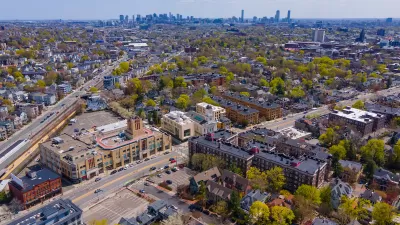In Joel Kotkin's new book The Human City, he argues that suburbanization promotes higher birthrates. But this policy doesn't seem to have worked so far.

In his new book The Human City, Joel Kotkin correctly points out that the more affluent parts of the world are facing a "Birth Dearth": birth rates have declined and populations have rapidly aged, which means that in the future, there may not be enough working-age taxpayers to support old-age retirement programs and other social programs. He also correctly notes that urban cores tend to have fewer children and smaller families than suburbs. He therefore concludes that "[w]ithout places for people to move farther out in the periphery, these core cities, with their low birth rates… are hardly sustainable in the long run." In other words, Kotkin's logic seems to be something like this:
Assumption 1: Society needs more children.
Assumption 2: Society cannot have more children without continued suburbanization, because parents will never again be willing to bring up children in cities.
Assumption 3: By contrast, parents are willing to bring up children in suburbia.
Conclusion: Therefore, suburbanization is necessary for more children.
However, both Assumption 2 and Assumption 3 are highly questionable.
Kotkin correctly notes that housing prices have exploded in big cities, and admits that "middle-income housing affordability constitutes a huge constraint on family formation in many cities… Virtually all of the countries with ultra-low birth rates [ ] suffer from very high housing prices." Thus, housing prices have driven middle-class families out of the world's more desirable cities. (Since Kotkin's book is not really focused on declining, low-demand cities, I shall not focus on their problems in this essay.)
But it doesn't follow from this that cities can never be family-friendly. Instead, it follows that if urban housing prices were lower, cities would become more popular with families. Since prices tend to be governed by the law of supply and demand, it further follows that a smart growth strategy of allowing more housing construction in cities would make cities more appealing to families.
However, current law precludes such policies; the most expensive cities often have zoning rules that are more restrictive than those of the typical American city. For example, in most American cities, city councils have veto power over rezoning. But New York City adds other possible choke points by giving borough presidents the right to review rezoning, and by creating community boards which also have the right to comment on development proposals. Finally, the city bureaucracy on its own can propose downzoning a neighborhood, which means that the zoning code permits even less new housing than in the past. (In the mid-2000s, the city downzoned 40,000 parcels of land.) Similarly, San Francisco has unusually restrictive zoning policies. For example, San Francisco allows the city bureaucracy to veto even development that conforms to the existing zoning code. Because zoning laws artificially limit urban housing supply (and thus increase urban housing prices) it seems to me that zoning deregulation would increase the housing supply and thus reduce housing prices, thus making cities more family-friendly. So one might think that Kotkin would favor allowing more housing in existing city neighborhoods.
But more housing in a neighborhood means, by definition, that the neighborhood becomes a little more dense. And Kotkin does not approve of density, writing that "higher-density housing is far more expensive to build… [because] the cost of developing a garden apartment is roughly one-third that of developing a high-rise." But Kotkin's claim is based on a false dichotomy: he implies that "higher-density housing" is the same as high-rises, and thus that new housing must either be low-density suburbia or high-rises. In fact, urban housing can be quite dense (and family-friendly) without being high-rise. Kotkin of all people should know this, since he writes that his father grew up in Brooklyn’s Flatbush neighborhood when it was "very much a place for middle-class families," and describes the nearby Ditmas Park neighborhood as one where people move "to escape a culture dominated by childless people." These low-rise neighborhoods are hardly low-density suburbs: both Flatbush and Ditmas Park have between 65,000 and 68,000 people per square mile (nearly twice the Brooklyn average).
If most cities built neighborhoods as dense as Ditmas Park, there would be no need for suburbs (or for that matter, high rises). For example, if all of New York City was built at the density of Ditmas Park, it could accommodate 20.3 million people- more than twice its current population, and roughly the population of the entire New York metropolitan area.
Kotkin's second major assumption is that because suburbs have more families than cities, more suburbs mean more babies. But Kotkin also notes that suburbs have grown faster than urban cores, both in the United States and Europe. So if suburbs are growing everywhere and suburbs are good for children, therefore we should see rising birth rates everywhere, especially in the suburb-dominated United States.
But in fact, the opposite has occurred. In 1950, at the dawn of the suburban era, the birth rate (that is, the number of births per 1000 people) was 24.1; in 2013, the same number was 12.5. Similarly, the fertility rate (the number of live births for women between 15 and 44) declined from 106.2 per 1000 women to 62.9. (European birthrates have declined to a roughly similar extent).
Someone in 1950 might have bet that the suburban experiment would protect the United States and other affluent nations from declining fertility. But the verdict of history is in. Suburbia failed.

Pennsylvania Mall Conversion Bill Passes House
If passed, the bill would promote the adaptive reuse of defunct commercial buildings.

Coming Soon to Ohio: The Largest Agrivoltaic Farm in the US
The ambitious 6,000-acre project will combine an 800-watt solar farm with crop and livestock production.

World's Largest Wildlife Overpass In the Works in Los Angeles County
Caltrans will soon close half of the 101 Freeway in order to continue construction of the Wallis Annenberg Wildlife Crossing near Agoura Hills in Los Angeles County.

California Grid Runs on 100% Renewable Energy for Over 9 Hours
The state’s energy grid was entirely powered by clean energy for some portion of the day on 37 out of the last 45 days.

New Forecasting Tool Aims to Reduce Heat-Related Deaths
Two federal agencies launched a new, easy-to-use, color-coded heat warning system that combines meteorological and medical risk factors.

AI Traffic Management Comes to Dallas-Fort Worth
Several Texas cities are using an AI-powered platform called NoTraffic to help manage traffic signals to increase safety and improve traffic flow.
City of Costa Mesa
Licking County
Barrett Planning Group LLC
HUD's Office of Policy Development and Research
Mpact Transit + Community
HUD's Office of Policy Development and Research
Tufts University, Department of Urban and Environmental Policy & Planning
City of Universal City TX
ULI Northwest Arkansas
Write for Planetizen
Urban Design for Planners 1: Software Tools
This six-course series explores essential urban design concepts using open source software and equips planners with the tools they need to participate fully in the urban design process.
Planning for Universal Design
Learn the tools for implementing Universal Design in planning regulations.



























